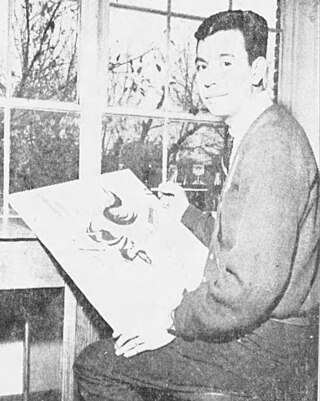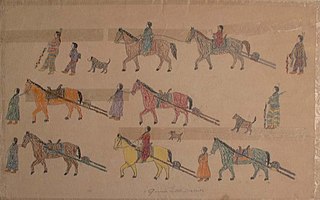
The Lakota are a Native American people. Also known as the Teton Sioux, they are one of the three prominent subcultures of the Sioux people, with the Eastern Dakota (Santee) and Western Dakota (Wičhíyena). Their current lands are in North and South Dakota. They speak Lakȟótiyapi—the Lakota language, the westernmost of three closely related languages that belong to the Siouan language family.

The Hunkpapa are a Native American group, one of the seven council fires of the Lakota tribe. The name Húŋkpapȟa is a Lakota word, meaning "Head of the Circle". By tradition, the Húŋkpapȟa set up their lodges at the entryway to the circle of the Great Council when the Sioux met in convocation. They speak Lakȟóta, one of the three dialects of the Sioux language.

The Rosebud Indian Reservation is an Indian reservation in South Dakota, United States. It is the home of the federally recognized Rosebud Sioux Tribe, who are Sicangu, a band of Lakota people. The Lakota name Sicangu Oyate translates as the "Burnt Thigh Nation", also known by the French term, the Brulé Sioux.
Mary Brave Bird, also known as Mary Brave Woman Olguin and Mary Crow Dog was a Sicangu Lakota writer and activist who was a member of the American Indian Movement during the 1970s and participated in some of their most publicized events, including the Wounded Knee Incident when she was 18 years old.

The Institute of American Indian Arts (IAIA) is a public tribal land-grant college in Santa Fe, New Mexico, United States. The college focuses on Native American art. It operates the Museum of Contemporary Native Arts (MoCNA), which is housed in the historic Santa Fe Federal Building, a landmark Pueblo Revival building listed on the National Register of Historic Places as Federal Building. The museum houses the National Collection of Contemporary Indian Art, with more than 7,000 items.
Joseph M. Marshall III son of Joseph Nelson Marshall Sr. and Hazel Lorraine Two Hawk-Marshall, is a historian, writer, teacher, craftsman, administrator, actor, and public speaker. He was a founding board member in 1971 of Sinte Gleska University, the tribal college at the Rosebud Indian Reservation.

Olive Rush was a painter, illustrator, muralist, and an important pioneer in Native American art education. Her paintings are held in a number of private collections and museums, including: the Brooklyn Museum of New York City, the Haan Mansion Museum of Indiana Art, the Indianapolis Museum of Art, Indiana and the Smithsonian American Art Museum.
Mary Frank is an English visual artist who works as a sculptor, painter, printmaker, draftswoman, and illustrator.

The Oglala are one of the seven subtribes of the Lakota people who, along with the Dakota, make up the Očhéthi Šakówiŋ. A majority of the Oglala live on the Pine Ridge Indian Reservation in South Dakota, the eighth-largest Native American reservation in the United States.

Čhetáŋ Sápa(Black Hawk) (c. 1832 – c. 1890) was a medicine man and member of the Sans Arc or Itázipčho band of the Lakota people. He is most known for a series of 76 drawings that were later bound into a ledger book that depicts scenes of Lakota life and rituals. The ledger drawings were commissioned by William Edward Canton, a federal "Indian trader" at the Cheyenne River Indian Reservation. Black Hawk's drawings were drawn between 1880-1881. Today they are known as one of the most complete visual records of Lakota cosmology, ritual and daily life.
Amos Bad Heart Bull, also known as Waŋblí Wapȟáha, was a noted Oglala Lakota artist in what is called Ledger Art. It is a style that adapts traditional Native American pictography to the new European medium of paper, and named for the accountants' ledger books, available from traders, used by the artists for their drawings and paintings. He was also the tribal historian of the Oglala, as his father Bad Heart Bull was before him.

Roxanne Swentzell is a Santa Clara Tewa Native American sculptor, ceramic artist, Indigenous food activist, and gallerist. Her artworks are in major public collections and she has won numerous awards.

Ledger art is narrative drawing or painting on paper or cloth, predominantly practiced by Plains Indian, but also from the Plateau and Great Basin. Ledger art flourished primarily from the 1860s to the 1920s. A revival of ledger art began in the 1960s and 1970s. The term comes from the accounting ledger books that were a common source of paper for Plains Indians during the late 19th century.
Teri Greeves is a Native American beadwork artist, living in Santa Fe, New Mexico. She is enrolled in the Kiowa Indian Tribe of Oklahoma.

Moses Stranger Horse (1890–1941) was a Brulé Lakota realist painter from the Rosebud Indian Reservation in South Dakota.

Arthur Douglas Amiotte is an Oglala Lakota Native American painter, collage artist, educator, and author.

Rosebud Yellow Robe (Lacotawin) was a Native American folklorist, educator and writer of half Lakota Sioux birth. Rosebud was influenced by her father Chauncey Yellow Robe, and used storytelling, performance and books to introduce generations of children to Native American folklore and culture.
Dyani White Hawk is a contemporary artist and curator of Sicangu Lakota, German, and Welsh ancestry based out of Minnesota. From 2010 to 2015, White Hawk was a curator for the Minneapolis gallery All My Relations. As an artist, White Hawk's work aesthetic is characterized by a combination of modern abstract painting and traditional Lakota art. White Hawk's pieces reflect both her Western, American upbringing and her indigenous ancestors mediums and modes for creating visual art.

Annie Little Warrior (1895–1966) was a Hunkpapa Lakota artist from the Standing Rock Reservation and an early woman ledger artist. She was also known by the names Annie Red Tomahawk and Mrs. Henry Red Tomahawk.

Jaw/Ćehu'pa, also known as His Fight/Oki'cize-ta'wa, was a Hunkpapa (Húŋkpapȟa) Lakota Winter count keeper and Ledger art artist













